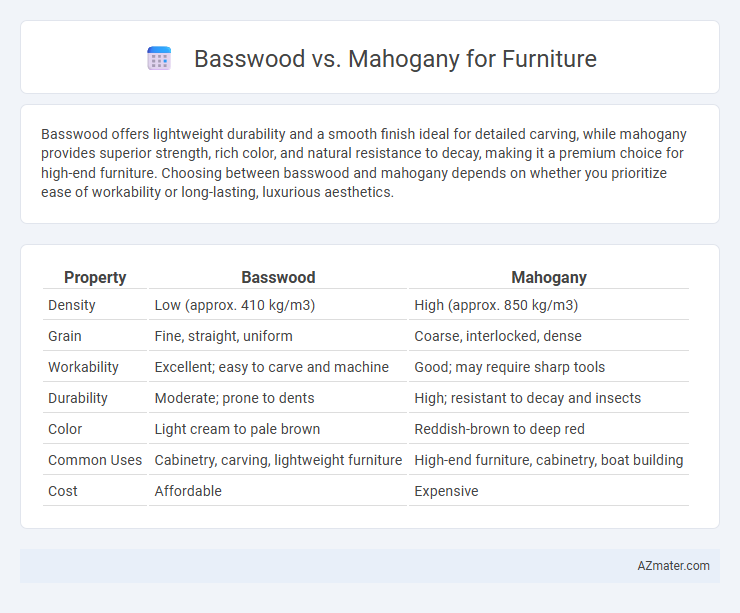Basswood offers lightweight durability and a smooth finish ideal for detailed carving, while mahogany provides superior strength, rich color, and natural resistance to decay, making it a premium choice for high-end furniture. Choosing between basswood and mahogany depends on whether you prioritize ease of workability or long-lasting, luxurious aesthetics.
Table of Comparison
| Property | Basswood | Mahogany |
|---|---|---|
| Density | Low (approx. 410 kg/m3) | High (approx. 850 kg/m3) |
| Grain | Fine, straight, uniform | Coarse, interlocked, dense |
| Workability | Excellent; easy to carve and machine | Good; may require sharp tools |
| Durability | Moderate; prone to dents | High; resistant to decay and insects |
| Color | Light cream to pale brown | Reddish-brown to deep red |
| Common Uses | Cabinetry, carving, lightweight furniture | High-end furniture, cabinetry, boat building |
| Cost | Affordable | Expensive |
Introduction to Basswood and Mahogany
Basswood and mahogany are two popular hardwoods extensively used in furniture making, each renowned for unique qualities. Basswood is a lightweight, pale hardwood with a fine, even texture, prized for its smooth finish and ease of carving, often favored in intricate woodworking projects. Mahogany, characterized by its rich reddish-brown hue and dense grain, offers exceptional durability and resistance to decay, making it a preferred choice for high-end, long-lasting furniture pieces.
Wood Characteristics: Basswood vs Mahogany
Basswood features a pale, creamy color with a fine, even texture and soft grain, making it easy to carve and ideal for lightweight furniture requiring detailed craftsmanship. Mahogany boasts a rich, reddish-brown hue with a straight, fine grain and excellent durability, offering strength and a luxurious finish suitable for heirloom-quality pieces. Basswood's lower density results in less resistance to wear, while mahogany provides superior hardness and natural resistance to decay, influencing their applications in furniture making.
Durability and Strength Comparison
Basswood offers moderate durability and strength, making it suitable for lightweight furniture but less ideal for heavy-use items. Mahogany is renowned for its exceptional strength and durability, with dense grain patterns that resist wear and damage over time. For long-lasting, sturdy furniture, mahogany outperforms basswood significantly in terms of structural integrity and resistance to impact.
Appearance and Grain Differences
Basswood features a light, creamy color with a fine, even grain that provides a smooth surface ideal for painting and carving. In contrast, mahogany displays a rich, reddish-brown hue with a pronounced, interlocking grain pattern that enhances its natural luster and depth. The distinct grain complexity of mahogany offers a luxurious, elegant look, while basswood's subtle texture creates a clean and minimalistic aesthetic for furniture.
Workability and Craftsmanship
Basswood offers superior workability due to its soft, fine-grained texture, making it ideal for intricate carvings and detailed craftsmanship. Mahogany, although harder, provides excellent durability and a smooth finish that enhances furniture aesthetics while demanding more skillful handling during construction. Both woods are favored in fine furniture making, but basswood excels in ease of shaping, whereas mahogany stands out for its strength and rich appearance.
Cost and Availability of Each Wood
Basswood offers a budget-friendly option for furniture, typically costing less than mahogany, making it ideal for cost-conscious projects. Basswood is widely available in North America, ensuring steady supply and easier sourcing for manufacturers and DIY enthusiasts. In contrast, mahogany commands a higher price due to its premium quality and slower growth, while availability is more restricted, often requiring import from tropical regions.
Environmental Impact and Sustainability
Basswood is a fast-growing hardwood that regenerates quickly, making it a more sustainable choice for furniture production compared to slow-growing mahogany, which often faces overharvesting concerns. Mahogany's extraction frequently involves deforestation in tropical regions, negatively impacting biodiversity and contributing to carbon emissions. Sustainable forestry certifications like FSC help mitigate environmental harm, with basswood plantations typically adhering to more responsible management practices.
Suitability for Different Furniture Types
Basswood's lightweight and fine grain make it ideal for intricate carvings and decorative furniture pieces like cabinets and frames, offering a smooth surface that paints and stains well. Mahogany's dense, durable nature suits heavy-use furniture such as dining tables, chairs, and bed frames, providing strength and a rich, reddish-brown finish that ages beautifully. Selecting basswood enhances delicate designs, while mahogany ensures longevity and classic appeal for robust furniture.
Maintenance and Longevity
Basswood offers easy maintenance due to its soft grain and resistance to insect damage, making it ideal for indoor furniture with moderate use. Mahogany features exceptional durability and natural resistance to decay and moisture, resulting in furniture that can last for decades with minimal upkeep. Both woods benefit from periodic polishing, but mahogany's dense structure requires less frequent refinishing compared to the more porous basswood.
Choosing the Right Wood for Your Furniture Project
Basswood offers a lightweight, soft texture ideal for intricate carving and affordable furniture projects, while mahogany provides exceptional durability, rich reddish-brown color, and resistance to rot, making it perfect for high-end, long-lasting pieces. Consider basswood for indoor furniture requiring detailed craftsmanship and mahogany for items exposed to wear or moisture with a need for elegant aesthetics. Selecting the right wood depends on your project's functional needs, budget, and desired finish, balancing basswood's workability against mahogany's strength and luxury appeal.

Infographic: Basswood vs Mahogany for Furniture
 azmater.com
azmater.com